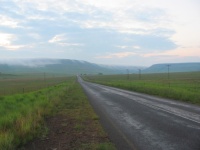
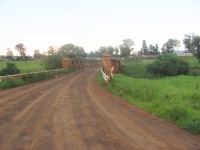
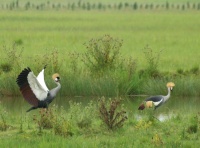
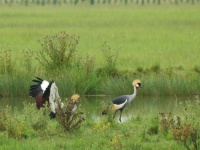
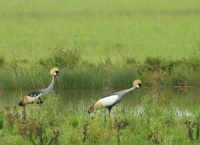
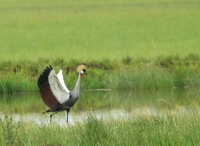
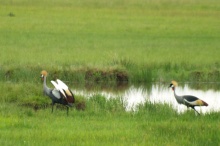
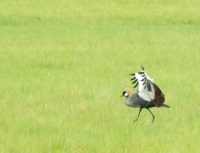
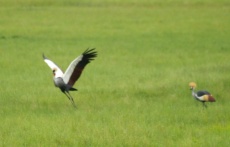
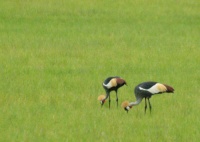
In December 2010 we broke with out annual pilgrimage to the Kruger National Park and headed to the Zululand in KwaZulu/Natal. We booked a week of accommodation at Bundu Basher Inn (just 3kms outside of the town - it was really affordable and more than adequate for our needs) and used that as our base to holiday and bird that part of the country. We made two trips to Cape Vida, a trip to Sodwana Bay, a visit to Muzi Pans, a trip to Richards Bay and a trip to Mtunzuni. In total we saw around 180 bird species in the week and I recorded 16 Lifers to add to my life lists (bringing it to 436). Here is a report on our experiences:
Day 1: The Trip to St. Lucia
I allowed my GPS to determine the best route and it ended up being the long way around - through Memel, Vryheid and Volksrust. However it was really scenic and also gave us a great surprise in seeing a male Grey Crowned Crane trying to impress a lady Crane:
We arrived at the small pan near Muzi Pan where a Rufous-bellied Heron had been seen in recent days and looked in vain for the secretive bird. Keep reading for an update on my adventure with this bird!!!
Our next stop was Muzi Pans where a few days back I had spotted Buff-breasted Sandpiper and Pectoral Sandpiper - there were about a dozen birders at the spot hoping to see the Sandpipers. I managed to get a pic of a Southern Brown-throated Weaver that I had never seen before. Lifer number 1 for the trip! I also snapped an interesting pic of a raptor that some have identified as European Honey-Buzzard.
We realised that we were only about 50kms away from Sodwana Bay and my kids were desperate for a swim in the sea so we spent the rest of the afternoon at the beach. I got to do the walk along the dune forest - and realised once again how difficult it is to bird in forests - you hear so much but actually see so little! We saw the first of dozens of Yellow-billed Kite's that we would see all along the coast line. I managed to get up close to Broad-billed Roller that I had only seen on one occasion before! On the way back to St. Lucia we saw our first and only Purple-crested Turaco for the trip! Just imagine what these pics would have looked like if we were not surrounded by a huge storm!
We arrived in St. Lucia - unpacked at our accommodation and headed into town to explore the beach. We got to see an incredible sunset and were standing not more than 20 meters away from huge crocs on the lagoon and not more than 50 meters away from huge Hippos that were coming onto the beach to forage. It was an amazing experience. We saw more Southern Brown-throated Weaver building their nests and watched White-fronted Plover foraging on the beach after nightfall - lifer number 2 for me.
Day 2: Igwala Trail and Boat Trip
On the second day my wife and I got up before dawn to do the Igwala Walk that is situated in the town and in the forest at the edge of the lagoon. I returned to the spot later that afternoon for another experience - here is a synthesis of both walks:
As with all forest birding it was tough going and required great patience and much sore necks and dealing with the biting insects in the tropical forest was not easy - but we persevered and managed to record the following lifers: Rudd's Apalis, Yellow-rumped Tinkerbird, Livingstone's Turaco, Woodward's Batis, Green-backed Camoroptera (finally not the Grey-backed species!), Yellow-bellied Greenbul (which later during our trip we would realise is as common on the coast as Dark-capped Bulbul in Johannesburg - just a lot louder), and Grey Waxbill (I only have Cinderella and Yellow-bellied Waxbill left to photograph):
Some of the other highlights on the trail included Sombre Greenbul (it's call always confuses me and it takes some time to make the connection), Crowned Hornbill and Trumpeter Hornbill, Black-backed Puffback (at last I got to see the Puffback on display and also a mating moment), Red-capped Scrub-Robin (this is my photographic nemesis bird - I just can't get a decent photo of this little chap!), Collared Sunbird, Caspian Tern (flying over the lagoon on the edge of the forest), Dark-backed Weaver (only my second sighting), Yellow Weaver, Spectacled Weaver and White-eared Barbet (also a common sighting on the coast).
One of the highlights was seeing a pair of Yellow-billed Kite flying low overhead and then stumbling across their nest in the forest:
A huge highlight of our time in St. Lucia was a trip on the boat up the estuary. It took about 2 hours and got us up close to crocodile, hippo and water birds. It was real value for money at R160 per person. I got my first sighting of juvenile Purple Swamphen and a third lifer as a Caspian Tern flew past! I was surprised to see the endangered Saddle-billed Stork.
A fly by of a Pink-backed Pelican that landed near the boat was amazing!
A lonely Grey-headed Gull also delighted us with a fly by:
One of the highlights of the boat trip was getting super close to an African Fish-Eagle that was perched on a tree at the water's edge:
A raptor flew past that the captain identified as African Fish-Eagle - and it could be either a juvenile Fish-Eagle or what I believe is an Osprey:
A massive flock of Waders landed too far from the boat to get great pics and the captain was not going to risk getting stuck in the mud (the water levels in the estuary are at an all time low) no matter how much I begged. So identifying them apart from the Ruff is not really possible.
When the Captain suggested that there was a Yellow-billed Kite flying behind us, my 15 year old daughter corrected her and said that it was an African Harrier-Hawk. I was rather impressed with Ashley!
One of the interesting facts that we learnt while on the boat was that these interesting features on branches in trees are actually ant nests:
As we disembarked we enjoyed watching Yellow, Brown-throated and Lesser-Masked Weaver building their nests and watched an African Pied Wagtail feeding a demanding juvenile:
Before we headed home for lunch we drove down to the lagoon and enjoyed watching Caspian Tern and Gulls on a sandbank not far from the shoreline:
At nightfall we made another trip to the estuary mouth and managed to get better pics of the White-fronted Plover that we had seen the previous evening as well as a second sighting for the day, and my life, of Caspian Tern:
Day 3: Isimangaliso Wetland Park - Lake St. Lucia (Southern Section)
On day 3 we got up before dawn to join the line of cars making their way to Cape Vidal - only 120 cars are allowed into the wetland park so you have to get up early (hey, that is what we birders do anyway right!). Even though we were at the gate by 5:15 it still took us an hour to get into the park. We spent the two or three hours slowly exploring the wetland park (with the goal of getting to the beach at Cape Vidal around 10 so the kids could enjoy the beach).
We recorded the following birds around the gate entrance: Rattling Cisticola, European Bee-eater, Yellow-billed Kite, Burchell's Coucal, Black-chested Barbet, Dark-capped Bulbul and then we stopped off at the Amazibu Pan where we saw Spur-winged Goose, Blue-cheeked Bee-eater, Yellow-throated Longclaw, Blacksmith Lapwing, Pin-tailed Whydah, Wood Sandpiper and Three-banded Plover.
We took the Vlei Road loop where we had our breakfast stop and saw White-eared Barbet, Tawny-flanked Prinia, Black-backed Puffback,Cape Turtle-Dove, Crowned Hornbill, Lesser Striped Swallow, Yellow-billed Kite and Brown-hooded Kingfisher.
Our next stop was at Mission Rocks - a beautiful beach spot with rock pools and a chance to walk along the beach for about a kilometer. The ony birds we saw on the beach was a lonely White-breasted Cormorant and a Cape Wagtail:
We arrived at the picnic site at Catalina Bay and I took one look at the bay (the water levels are dangerously low and in fact on the western shores the resort spots have all closed down) and I knew that I just had to get closer. I tried unsuccessfully to get out to the water's edge to see the bird life from the picnic spot but there was a big marsh area hindering my way so we made our way to the jetty we saw in the distance and approached the waters edge from there. It was rather nerve racking given the size of the crocodiles in the water and the hippos not far off. It was the only way that I could get closer to try and identify the countless waders at the water's edge.
Here is a list of the birds that we saw around the bay: Yellow-bellied Greenbul, Speckled Mousebird, Grey Heron, Goliath Heron, White=fronted Plover, Curlew Sandpiper, Common Ringed Plover, Grey-headed Gull, Little Stint, Ruff, African Pipit, White-throated Swallow, and a bird flying away from me that just may have been Pectoral Sandpiper (judging by the dark bar on the tail feathers - I seem to recall ruling out Little Stint based on size - which was present in the area - so who knows???).
Next we completed the Dune Loop which was not hugely productive but an enjoyable route (we did see Black-backed Puffback, Ashy Flycatcher, Black-bellied Starling and Yellow-bellied Greenbul). After stopping to take shots of what I hoped was a Southern-banded Snake-Eagle which turned out to be Steppe Buzzard, we arrived at Cape Vidal where the kids enjoyed swimming in the sea and I chose to do some birding on the trail that follows the shore line. It was less than impressive but it was the wrong time of the day. I actually heard many birds but saw just a few that I could identify including Purple-banded Sunbird, Bearded Woodpecker, Tawny-flanked Prinia, Brown-hooded Kingfisher, Cape White-eye and Ashy Flycatcher (building a nest together):
After a picnic lunch at the beach we made our way back towards St. Lucia, but took the long Grassland Loop road which passed Lake Bhangazi which was a highlight. We stopped on the road and walked down to the waters edge - just as well, otherwise I would never have seen the Collared Pratincole that was taking a bath in the shallow waters. I really enjoyed taking these pics of the Water Thick-knee, but the 2 massive crocs just behind the bird nearly scared me spitless - I doubt that I would have been able to outrun them had they decided to leave the water and chase me. The other highlight at this spot was a Yellow-billed Kite that had landed to take a drink and the Woolley-necked Stork, African Spoonbill and Goliath Heron at the waters edge.
As we ended the Grassland Loop we spotted two Secretarybirds in the grass and another Steppe Buzzard perched on a telephone pole - again sadly not a Snake-Eagle.
Here are some pics of the mammals that we saw during the day:
Day 4: Mtunzini and Richards Bay
We headed off from St. Lucia in search of the Palmnut Vulture and Crab Plover - and our first stop was the little town on the North Coast of Mtunzini. We found the spot in the suburb where the Palmnut Vulture is supposed to hang out but had no luck spotting it. We spoke to some locals who said that we might have more luck in the reserve. Before we headed to the nature reserve we explored the valley to the north of the monument site. Here I saw Fork-tailed Drongo, Eastern Olive Sunbird, Bronze Mannikin (alas, no Red-backed or Pied Mannikin in sight), Cape White-eye, Yellow Weaver, African Paradise-Flycatcher, Yellow-bellied Greenbul and Sombre Greenbul.
Our next stop was the Wetland Reserve which runs next to the Mtunzini River. We met a gentleman who showed us a pic that he had taken just an hour ago of a Palmnut Vulture snacking on crabs in the wetland so we were rather hopeful of finding this special - but we had no luck! We did get to see Common Sandpiper, Common Greenshank, African Pied Wagtail, Purple-banded Sunbird, Willow Warbler, Black-backed Puffback and a Common Whimbrel (which was out in the middle of the lagoon and did not look like it was about to come to the shore - so my pic is pretty lame). As we left the reserve we saw a flock of Woolly-necked Stork flying overhead and an African Fish-Eagle.
The day was moving on so we headed off to Richards Bay (my kids were bugging me to get to the beach). We found the Thulasihleka Pan Bird Sanctuary near to the harbour but the howling wind and the absence of birds was a bit of a disappointment. We were entertained by a group of Pink-backed Pelican that were fishing up and the down the pan, as well as Pied Kingfisher, African Jacana, Little Swift and Yellow Weavers. This site had the most unique bird hide I have ever seen - it is attached to a concrete structure.
We then saw a little spot with potential along a river where we stopped to have a picnic lunch and watch some Grey-headed Gull arrive to do some fishing.
We headed to the main beach so the kids could swim, but the wind was incredible and no one was going to risk getting sandblasted. We decided to head to the beaches near the harbour which are a bit more sheltered and out kids got to swim there for an hour. A boat with fishermen out on the bay was attracting a good amount of Gulls and a flock of what I believe is Lesser Crested Tern flew past:
A small flock of birds caught my attention and I initially identified them as Red-billed Quelea, but I am not so sure that is correct. Any ideas about their id?
So, no Crab Plovers on the day, but an awesome family outing and some good birding along the way.
Day 5: Iphiva Trail and Charters Creek
My wife and I got up early to do the Iphiva Trail that starts near to the Crocodile Center. We were disappointed by the lack of bird life in the forest and dunes - but we did get to hear and briefly see Narina Trogon (which, had I gotten a photo, would have been a lifer!). We did get to see Livingstone's Turaco and Black-bellied Starling.
We were done by 10am so I headed off to try my luck again at the Igwala Trail while my family went shopping in the town. I met up with a group of birders who pointed out a nesting Lemon Dove (a lifer for me) and I got a half decent pic using flash of a Lemon Dove in the shadows.
A highlight was watching an Osprey fishing in the lagoon. It tried two times unsuccessfully to catch lunch before succeeding on the third try. I was a long way away from the action, but these pics still capture some of the action I trust:
Our kids were enjoying swimming at the Inn where we were staying and they were happy to stay behind as we headed off to Charter Creek. It is a resort on the western shores of the lake - that were were to discover is no longer operation due to the incredibly low water levels in Lake St. Lucia. It is really sad to see what was once a thriving resort - hopefully the area will receive decent rains in coming years so that the situation can be reversed.
When we arrived at the beach we could see birds in the distance and curiosity got the better of me and we just had to make our way on foot out through the dry shoreline towards the waters edge - probably about 200 meters from the jetty.
We were on the lookout for crocs and hippos and it was rather eerie given that the place was deserted and there was not another person around. We spent about an hour trying to get close to the birds on the water - including Caspian Tern, Common Greenshank, Goliath Heron, White-fronted Plover and we saw Greater Flamingo in the distance but could not get closer to get decent pics.
On the way home we finally saw Guineafowl, but were disappointed that it was Helmeted and not Crested which we had searched for all over the area.
Day 6: Muzi Pans and False Bay
I headed off at the crack of dawn to have a second shot at finding the Rufous-bellied Heron at the small pan south of Muzi Pans. I arrived and spotted Red-billed Teal, Reed Cormorant, Black Crake, Pied Crow, Little Grebe, Common Myna, Common Waxbill, Malachite Kingfisher, Fan-tailed Widowbird, Blue-cheeked Bee-eater and Three-banded Plover.
Suddenly (at 7:03) I noticed a movement in front of the reeds, grabbed my binocs (snapped a hopeful shot) and my adventure with the Rufous-bellied Heron had begun. It moved into view for a split second (at 7:05) but soon disappeared into the reeds. Would that be all I would see of it?
I waiting for what seemed like forever to see it again, even walked around the pan to get closer to the reeds but nothing moved. At 7:55 (almost an hour after I had first seen it, I decided to approach the reeds from the back and try to gently encourage the Heron to move). It worked - the moment I got closer it took off. I snapped a fuzzy shot in desperation and wondered if it would leave the area completely. Fortunately it flew to a corner of the pan allowing me to get a few more shots. Still out of my range!
As I approached closer it flew to the other side of the pan - this chess game continued for another 20 minutes before I realised that I was not going to get any closer without disturbing the bird and with it showing in clear view I got into my car and drove away! What an experience!!!
I left the pan and headed for False Bay - I had learnt from our visit to Charters Creek that it the resort was most likely closed but wanted to check out the bird life anyway. I arrived, paid to enter a non-functional resort (weird!) and headed for the shoreline - which was just as dismal in terms of water levels as all the other spots around Lake St Lucia.
Here are some of the birds that I saw:
As I was leaving False Bay I got a phone call from a fellow birder to say that a Lesser Yellowlegs had been spotted at Muzi Pans. I decided to head to the pans right away. The place was deserted apart from locals and I headed out to the spot where the waders hang out near the waterline.
Here are some scenery pics of the abundant bird life at the spot:
Here is a list of all the birds that I recorded: Red-breasted Swallow, Yellow-billed Stork, Black-winged Stilt, White-breasted Cormorant, Cattle Egret, Great Egret, Little Egret, Spur-winged Goose, Black Heron, African Jacana, Red-billed Teal, Hottentot Teal, Blacksmith Lapwing, Burchell's Coucal, Black-headed Heron, Yellow-billed Duck, White-faced Duck, Sacred Ibis, Caspian Tern, Whiskered Tern, Pectoral Sandpiper, African Spoonbill, Southern Red Bishop, Grey Heron, Grey-headed Gull, Ruff, Wood Sandpiper, Goliath Heron and Klittlitz's Plover. Here are some bird pics:
As I scanned the numerous waders I looked for the Lesser Yellowlegs and first spotted the Pectoral Sandpiper that had caused so much interest in the spot the week before. Here are some pics of the Pectoral:
As I processed my pics I noticed a wader that could be the Lesser Yellowlegs (I am waiting for it to be confirmed - someone has suggested that it is Wood Sandpiper instead):
I headed back to St. Lucia and we headed to Mtubatuba where we did some driving around the farm area and some shopping at the Pick 'n Pay to make Christmas day special. I ended the day by completing the trail below the Crocodile Centre in St. Lucia. I recorded Sombre Greenbul, Yellow-rumped Tinkerbird, Fan-tailed Widowbird, Yellow-bellied Greenbul, Woolly-necked Stork, Crowned Hornbill, Trumpeter Hornbill, African Pied Wagtail, Pied Crow, Black-backed Starling, Black-headed Kingfisher, Livingstone's Turaco and Narina Trogon (I heard it but never got to see it).
Day 7: Cape Vidal
For Christmas day we once again got up at the crack of dawn to join the line of cars heading off to Cape Vidal. Christmas on a beautiful beach in KwaZulu Natal sounded perfect - and some birding along the way - paradise!
The first bird we saw was a juvenile Yellow-throated Longclaw. I initially thought it might be Yellow-breasted Pipit but they are found from 1500m above sea level!
Here is a list of the raptors that we saw on the way - at last a Snake Eagle, but no luck with the Southern-banded Snake-Eagle.
Another bird that remains a mystery is this Sunbird (it could be a rare female Plain-backed Sunbird - or is that just wishful thinking?):
Here are some of the other pics that I took:
A highlight for all of us was finally seeing Samango Monkey in the wild:
And that was it - we headed back towards Joburg at 4am on the 26th of December - stopping at my folks in Durban and then Witsieshoek near Harrismith and the Botha's Lark Triangle!